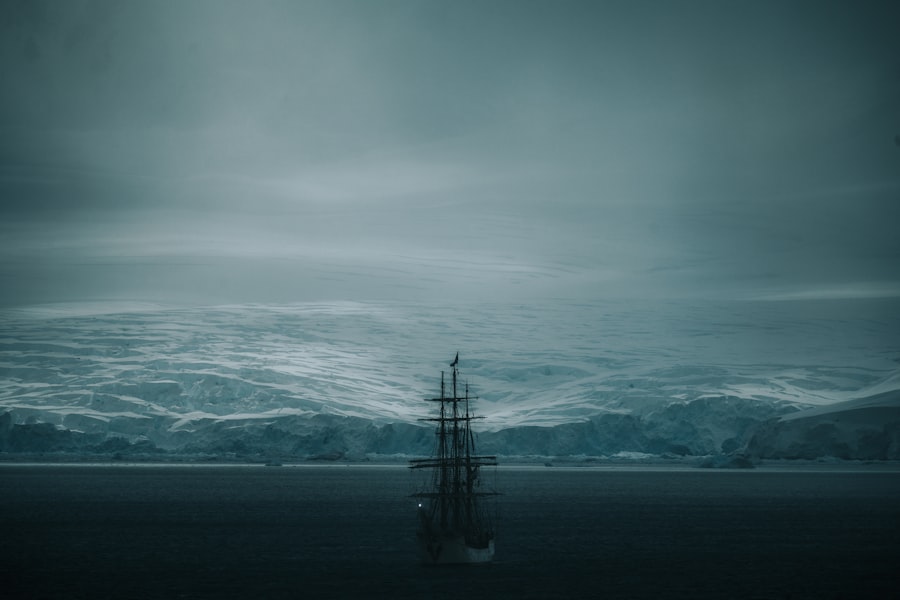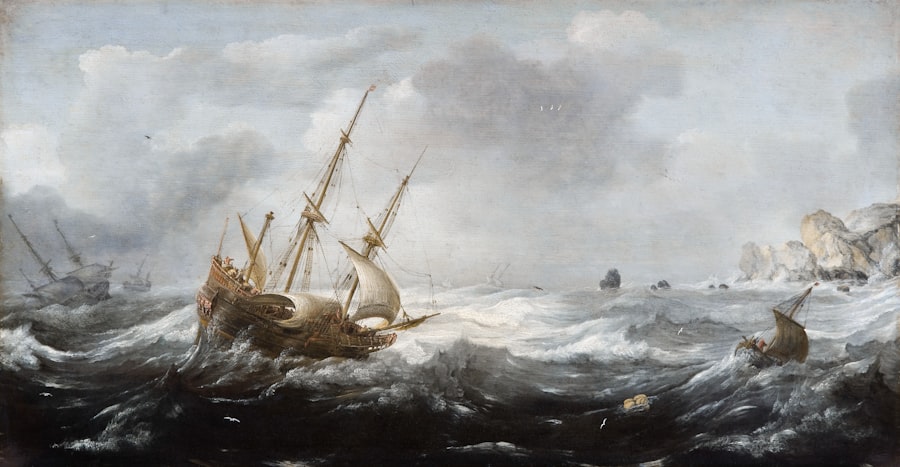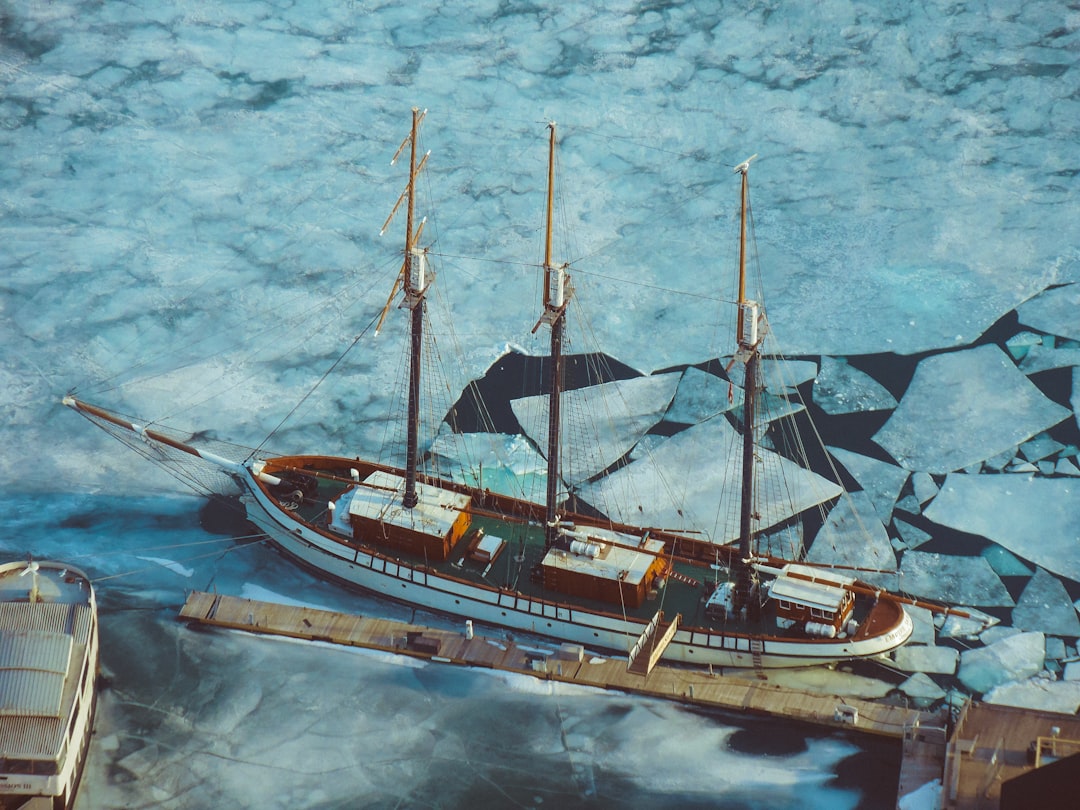The Drake Passage, a body of water situated between the southern tip of South America and Antarctica, is renowned for its tumultuous seas and unpredictable weather patterns. This narrow stretch of ocean, measuring approximately 800 kilometers (500 miles) wide, serves as a critical maritime route for vessels traveling to and from the Antarctic region. Named after the English explorer Sir Francis Drake, who navigated these waters in the late 16th century, the passage has become synonymous with both adventure and peril.
Its unique geographical position makes it a vital conduit for marine life and a significant area for scientific research, yet it is also infamous for its treacherous conditions that have claimed numerous ships and lives over the centuries. The Drake Passage is not merely a geographical feature; it embodies the spirit of exploration and the inherent risks that come with venturing into the unknown.
As such, it has captured the imagination of many, drawing researchers, tourists, and thrill-seekers to its shores, all eager to experience its raw beauty and daunting challenges.
Key Takeaways
- The Drake Passage is a treacherous body of water located between South America’s Cape Horn and the South Shetland Islands of Antarctica.
- The history of tragedies in the Drake Passage dates back to the 16th century, with numerous shipwrecks and disasters occurring due to its unpredictable weather and strong currents.
- The geography and climate of the Drake Passage are characterized by rough seas, high winds, and extreme cold, making it one of the most challenging maritime routes in the world.
- Navigating the Drake Passage poses various dangers, including icebergs, rogue waves, and hurricane-force winds, making it a perilous journey for ships and their crew.
- Notable shipwrecks and disasters in the Drake Passage include the sinking of the SS America, the loss of the Endurance during Ernest Shackleton’s expedition, and the tragic fate of the MV Explorer in 2007.
History of Tragedies in the Drake Passage
The history of the Drake Passage is marked by a series of tragedies that highlight the dangers inherent in navigating these waters. From the earliest days of exploration to modern maritime endeavors, countless vessels have met their fate in this unforgiving environment. The passage has witnessed shipwrecks that tell tales of human courage and folly, where the relentless sea has often proven to be an insurmountable adversary.
Historical records indicate that as early as the 17th century, ships were lost to storms and treacherous waves, setting a precedent for the dangers that would continue to plague mariners for centuries. One of the most notable tragedies occurred in 1914 when the SS Orinoco sank during a fierce storm while en route to Antarctica. The ship was carrying supplies for an expedition but was overwhelmed by the ferocity of the elements.
This incident served as a stark reminder of the Drake Passage’s unpredictable nature and foreshadowed many more disasters to come. Over time, as maritime technology advanced, so too did the understanding of these perilous waters; however, even modern vessels are not immune to the whims of nature. The passage remains a site where human ambition meets the raw power of the ocean, often with tragic consequences.
The Geography and Climate of the Drake Passage

Geographically, the Drake Passage serves as a natural barrier between two major landmasses: South America and Antarctica. This unique positioning results in a confluence of ocean currents that create some of the most turbulent waters on Earth. The Antarctic Circumpolar Current flows through this passage, contributing to its notorious reputation for rough seas.
The interaction between cold polar waters and warmer currents from the north creates a dynamic environment that can shift rapidly, leading to sudden storms and high waves that can reach heights of over 30 feet. The climate in the Drake Passage is equally unpredictable, characterized by strong winds and frequent precipitation. Sailors often describe it as a place where four seasons can occur in a single day.
Fog can roll in unexpectedly, reducing visibility to mere meters, while fierce gales can whip up waves that threaten even the sturdiest vessels. This volatile climate not only poses challenges for navigation but also affects marine life in the region. The rich biodiversity found in these waters is a testament to the ecological significance of the Drake Passage, yet it is also a reminder of how fragile this balance can be in the face of environmental changes.
The Dangers of Navigating the Drake Passage
| Category | Metrics |
|---|---|
| Weather | High winds, rough seas, and extreme cold |
| Icebergs | Potential for encountering large icebergs |
| Isolation | Lack of nearby assistance in case of emergency |
| Historical Incidents | Record of shipwrecks and maritime disasters |
Navigating the Drake Passage is fraught with dangers that have been well-documented by sailors throughout history. The combination of strong currents, unpredictable weather patterns, and shifting icebergs creates an environment where even experienced mariners must exercise extreme caution. The passage is notorious for its “screaming fifties”—the latitudes between 50°S and 60°S—where winds can reach hurricane force, making navigation particularly treacherous.
These conditions demand not only skill but also an intimate understanding of weather patterns and ocean currents. Moreover, the isolation of the Drake Passage adds another layer of danger. In case of an emergency, help may be hours or even days away due to its remote location.
This isolation can exacerbate situations where vessels encounter mechanical failures or medical emergencies on board. The combination of these factors makes it imperative for those who dare to traverse these waters to be well-prepared and equipped with both knowledge and resources to handle potential crises.
Notable Shipwrecks and Disasters in the Drake Passage
Throughout its history, the Drake Passage has been the final resting place for numerous ships that have succumbed to its wrath. One particularly infamous shipwreck is that of the MV Explorer in 2007, which sank after hitting an iceberg while carrying tourists on an Antarctic cruise. The incident highlighted not only the dangers posed by ice but also raised questions about safety regulations in polar tourism.
Fortunately, all passengers were rescued, but this event served as a wake-up call for both travelers and operators regarding the risks associated with navigating these icy waters. Another tragic event occurred in 1982 when the Argentine Navy’s ARA General Belgrano was sunk during the Falklands War. This incident not only resulted in significant loss of life but also underscored the geopolitical tensions surrounding this remote region.
The wreckage remains a poignant reminder of both human conflict and nature’s indifference to such struggles. Each shipwreck tells a story—a narrative woven into the fabric of maritime history that reflects both human ambition and vulnerability against nature’s formidable forces.
The Impact of Tragedies on the Environment

The tragedies that have unfolded in the Drake Passage extend beyond human loss; they also have significant environmental implications. Shipwrecks can lead to pollution from fuel spills and cargo contamination, which can adversely affect marine ecosystems that are already vulnerable due to climate change and other human activities. The introduction of foreign materials into these pristine waters can disrupt local wildlife and alter habitats that have existed for millennia.
Moreover, as maritime traffic increases due to tourism and scientific expeditions, there is growing concern about the cumulative impact on this delicate environment. The potential for accidents rises with increased vessel movement, raising questions about how best to balance exploration with conservation efforts. Protecting this unique ecosystem requires not only awareness but also proactive measures to mitigate risks associated with navigation through these treacherous waters.
Rescue and Recovery Efforts in the Drake Passage
Rescue operations in the Drake Passage are complex endeavors that require coordination among various agencies and organizations. Given its remote location and harsh conditions, responding to emergencies can be challenging. Search and rescue missions often involve helicopters and specialized vessels equipped to operate in extreme weather conditions.
These operations are critical not only for saving lives but also for recovering wreckage and assessing environmental damage. In recent years, advancements in technology have improved rescue capabilities in this region. Satellite communication systems allow for better coordination during emergencies, while improved weather forecasting tools help mariners make informed decisions about their routes.
Despite these advancements, however, challenges remain due to unpredictable weather patterns that can hinder rescue efforts. The commitment to ensuring safety in these waters reflects a growing recognition of both human life and environmental stewardship.
The Future of Navigation in the Drake Passage
As maritime technology continues to evolve, so too does the future of navigation in the Drake Passage. Innovations such as automated navigation systems and enhanced weather forecasting tools promise to improve safety for vessels traversing these challenging waters. Additionally, there is an increasing emphasis on sustainable practices within polar tourism and research expeditions aimed at minimizing environmental impact while maximizing safety.
However, with advancements come new challenges; as more vessels enter these waters, there is a pressing need for regulations that ensure safe navigation while protecting fragile ecosystems. Collaborative efforts among nations will be essential in establishing guidelines that balance exploration with conservation efforts in this unique region. The future of navigation in the Drake Passage will depend on a collective commitment to safety, sustainability, and respect for one of nature’s most awe-inspiring yet perilous environments.
Safety Measures for Traveling through the Drake Passage
Traveling through the Drake Passage necessitates rigorous safety measures to mitigate risks associated with its unpredictable conditions. Mariners are advised to conduct thorough pre-voyage preparations that include detailed route planning based on current weather forecasts and sea conditions. Additionally, vessels should be equipped with state-of-the-art navigation technology and emergency response equipment to handle potential crises effectively.
Training is another critical component of safety measures; crew members must be well-versed in emergency protocols and familiar with survival techniques specific to cold-water environments. Regular drills can help ensure that everyone on board knows how to respond swiftly in case of an emergency. By prioritizing safety through preparation and training, those who navigate these treacherous waters can significantly reduce their risk while honoring the legacy of those who have come before them.
Personal Stories of Survival and Loss in the Drake Passage
The Drake Passage is not just a geographical feature; it is also a repository of personal stories—tales of survival against overwhelming odds and heartbreaking loss that resonate deeply within maritime history. Survivors from various incidents often recount their harrowing experiences navigating through storms or escaping sinking vessels with little more than their lives. These narratives serve as powerful reminders of human resilience in the face of nature’s fury.
Conversely, stories of loss echo through time as families remember loved ones who perished in these unforgiving waters. Memorials dedicated to those lost at sea stand as poignant tributes to their bravery and sacrifice. Each story adds depth to our understanding of this passage—not merely as a physical space but as a realm where human lives intersect with nature’s vastness.
Remembering the Victims and Honoring the Heroes of the Drake Passage
In conclusion, the Drake Passage stands as both a testament to human ambition and a reminder of nature’s formidable power. Its history is marked by tragedies that have claimed lives while also showcasing acts of heroism during rescue efforts amidst chaos. As we reflect on these events—both past and present—it becomes essential not only to remember those who have lost their lives but also to honor those who have dedicated themselves to ensuring safety within this challenging environment.
The future holds promise for safer navigation through improved technology and collaborative efforts aimed at protecting this unique ecosystem while allowing exploration to continue responsibly. By acknowledging both triumphs and tragedies within this remarkable passageway, society can foster a deeper appreciation for its complexities—ensuring that lessons learned from history guide future endeavors across these tumultuous waters.
The Drake Passage, known for its treacherous waters and unpredictable weather, has been the site of numerous maritime incidents over the years. These perilous conditions have unfortunately led to several tragic deaths, highlighting the dangers faced by those who navigate this infamous stretch of ocean. For more information on the challenges and history associated with the Drake Passage, you can explore a related article on the topic by visiting this page. This article delves into the geographical and historical significance of the Drake Passage, providing a comprehensive overview of why it remains one of the most feared maritime routes in the world.
WATCH NOW! Drake Passage: Earth’s Deadliest Waters Revealed
FAQs
What is the Drake Passage?
The Drake Passage is the body of water between the southern tip of South America and the northern tip of the Antarctic Peninsula. It is known for its rough seas and challenging sailing conditions.
How dangerous is the Drake Passage?
The Drake Passage is considered one of the most treacherous stretches of water in the world due to its strong winds, large waves, and unpredictable weather. It is notorious for its rough sailing conditions.
How many deaths have occurred in the Drake Passage?
There have been several recorded deaths in the Drake Passage, primarily due to accidents and extreme weather conditions. However, the exact number of deaths is not readily available.
What are the main causes of deaths in the Drake Passage?
The main causes of deaths in the Drake Passage are typically related to accidents, extreme weather conditions, and the challenging sailing conditions. These can include shipwrecks, capsizing, and hypothermia.
Are there safety measures in place for crossing the Drake Passage?
Yes, there are safety measures in place for crossing the Drake Passage, including strict regulations for ships and experienced crew members. However, the unpredictable nature of the passage means that it remains a challenging and potentially dangerous route to navigate.
